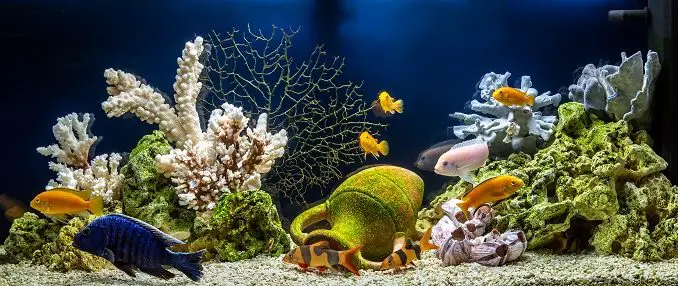
Deciding to start a new aquarium is always an exciting moment, but if you have never done it before, it can be a confusing time too.
Freshwater or marine? What size tank? Where will it go in the house? There are lots of questions that need answering, but one of the most important decisions is choosing which fish to get.
It’s easy to be drawn in by a beautiful species, to later find that isn’t suitable for your aquarium or it’s very difficult to care for.
Researching potential occupants is very important. You need to consider things such as their maximum size, diet, temperament, and preferred conditions. We have considered these factors and made a list of some of the best beginner fish. They are all easy to care for but still have their own unique appeals.
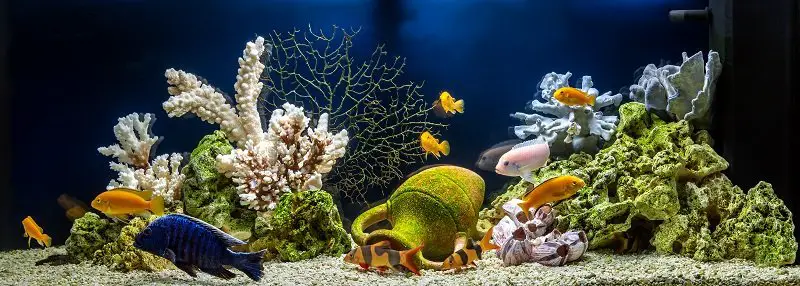
Related Reading: The Top 10 Best Fish for Kids
1. Danio
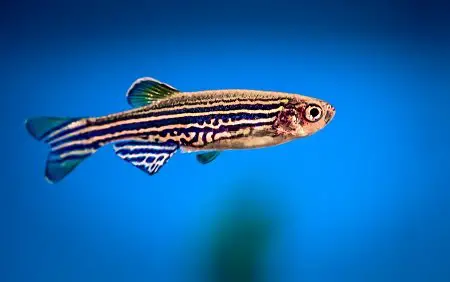
Danio is a popular choice for a beginner’s first fish. They are very hardy, which means they can be kept in a range of different setups, and they can survive some common mistakes that beginners are prone to making.
There are a few different forms that all come from Asia. The main two that you’ll likely see in stores are Zebra (striped) and Pearl (spotted) Danio.
Both designs are very appealing, especially when you keep them as part of a large shoal. They are very social and active creatures, even experienced aquarists enjoy caring for them.
Most beginners tend to purchase small aquariums initially, which means they can only keep small fish. Danio grows up to 2 inches and can be kept in tanks as small as 10 gallons.
These omnivorous fish will happily eat most foods that you drop into the water. They are also very easy to breed, making them a great choice for people starting a breeding tank for the first time.
They make peaceful additions to a community aquarium; they won’t cause problems for your other fish, or invertebrates. Do think carefully about potential tank mates though, large fish may eat them!
By keeping the tank clean and feeding them properly, you should have a healthy population of Danio for up to 5.5 years.
2. Cherry Barbs
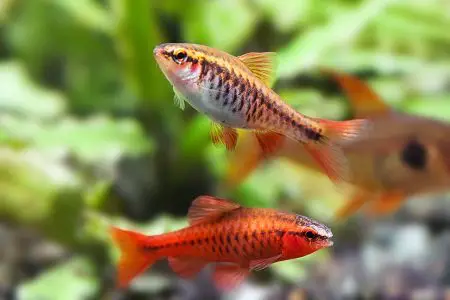
This is another safe, hardy option for a beginner aquarist. They are strong enough to survive small changes in their environment and will keep on swimming while you learn.
They come from the same family (Cyprinidae) as Danio, along with carps and minnows too. One thing that Cherry Barbs offer, which other related species might not, is color.
Their name comes from their red cherry color. Males display this particularly brightly, whereas females tend to be paler. Some people only keep males for this reason.
Ideally, your tank should be 25-30 gallons. This shoaling species thrives when it has plenty of open swimming space, coupled with some planted areas. Females also need space to hide while spawning.
Cherry Barbs are excellent for a community aquarium. Keep them with other small, peaceful species to produce a flurry of color and activity. You could add shrimp and/or snails too, which introduce some unique behaviors.
Feeding times are simple. Cherry Barbs will eat whatever they happen to find. This means you can use dried, live, or frozen foods, the latter two being more nutritious.
These fish breed regularly and will scatter eggs throughout your tank. If you want these to hatch, then separate them from your fish. Cherry Barbs provide no parental care, so the eggs might get eaten.
3. Corydoras Catfish
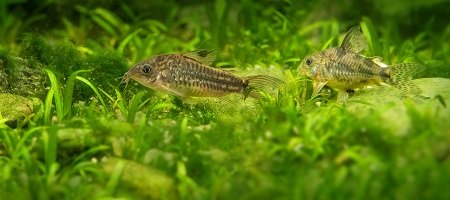
If you are looking for something to occupy the lower regions of your aquarium, you can’t go wrong with Corydoras (or “Corys”).
They are undemanding fish that mostly look after themselves. One thing to note is that your aquarium needs a soft substrate. Otherwise, they could damage their sensitive barbels when looking for food.
They spend most of their time in search of food. They are very effective at clearing up uneaten scraps that have fallen to the substrate, helping to clean the aquarium.
They will eat pretty much anything – both meat and vegetation. Some people have mistaken them for algae eaters, but this doesn’t make up a large part of their diet.
There are many different species of Corydoras available, from Bronze Corys to Bandit Corys. Each have their own distinctive appearance, so you will have to look around to find your favorite.
Most species are small and can fit in 10-gallon tanks. The smallest is the Pygmy Cory, which grows to 1 inch, maximum.
You should keep these fish in a peaceful community. It is very entertaining to watch them shuffle around the tank while other fish are active around them.
Many bottom-dwellers can be kept singly, but Corys are much happier when kept in small groups.
You could try breeding them. They mate regularly, but the small fry is prone to be eaten, so separate them.
4. Otocinclus Catfish
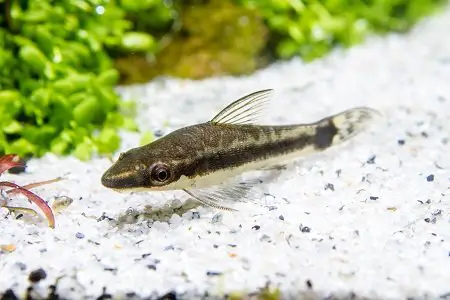
An alternative to Corydoras is Otocinclus Catfish (or “Otos”). These are small fish (1-2 inches) that are best known as algae-eaters.
Beginners often choose them for this reason. They latch onto surfaces and rasp off the algae, which helps to keep algae levels low. Algal blooms are a common issue for beginners.
It is an interesting sight to watch Otos attach themselves to the glass of your aquarium. You get a good view of their underside, particularly their strong mouth.
These herbivores will mostly eat algae, but you need to supplement this with algae wafers or green vegetables, especially if you notice algae levels getting low in the tank.
They are native to South America, where you’d find a few species with different appearances.
They are very peaceful and will generally ignore their tank mates. Make sure that the fish you keep with your Otos won’t be tempted to eat them since they are so small.
Otos are another example of a bottom-dweller that prefers being kept in groups of at least four. A single fish would get quite lonely and become stressed.
Beginners may struggle to breed these fish, but it is possible. The conditions in your tank must be perfect. If breeding fish is your main aim, Otos may not be the choice for you.
5. Molly Fish
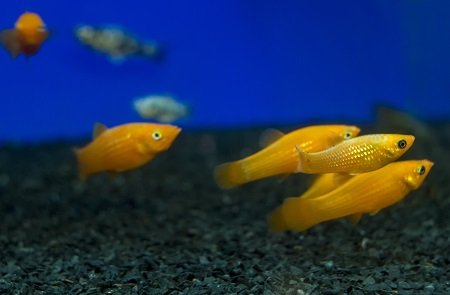
Molly fish (or “Mollies”) are some of the easiest fish to care for in the whole aquarium hobby. They mate regularly and will probably do so whether you want them to or not.
They are famous for being livebearers, which means that their eggs develop in their bodies and come out as live fry.
Even if you’re not trying to breed fish, Mollies can still be very desirable for a beginner aquarist. They are another hardy mid-water swimmer, and they can introduce lots of colors.
You can choose from a range of different colors. There are also some that feature special fins. The Sailfin Molly has a large dorsal fin that runs all along the body from the head to the caudal fin. The Lyretail Molly has a unique caudal fin; the top and bottom narrow into points that trail behind.
Most Mollies grow to be 4.5 inches, a small group of these shoaling fish can be kept in 10-gallon aquariums. This should contain a mixture of open swimming spaces and densely planted areas, especially when you are trying to breed them.
They work well as part of a community with other peaceful and similarly sized species. This includes many of the other fish on this list.
6. Damselfish
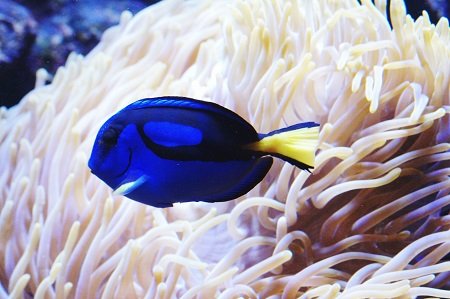
So far, we’ve only covered freshwater species. A freshwater aquarium is definitely the best option for a beginner, they are much easier to maintain compared to marine setups.
For those of you setting up a marine tank for the first time, damselfish is a great starting point.
People often choose a marine tank because of all the colorful fish options. Damselfish are very bright, usually displaying some bold blues, some with yellow accents.
They live for 5-6 years and usually grow up to 3 inches, but some breeds can reach 12 inches. A single 3-inch fish will need a 30-gallon tank, a small group will need much more.
This may seem like excess space, but it is needed to reduce territorial problems.
Damselfish belong to the Pomacentridae family, which includes many species. Some Damselfish varieties are peaceful and love other tank mates, but some can be very territorial.
It is important that you do your research about the variety you are buying since not all of them will be suitable.
These are hardy fish that can tolerate a range of conditions, which is why beginners should be able to keep them healthy.
A reef setup would be an ideal tank design, but some people aren’t confident with caring for corals, so rocks can be used instead.
Most varieties of Damselfish are omnivores, so you can use live, frozen or dried foods. Some varieties are herbivorous though, so check first.
7. Tetras
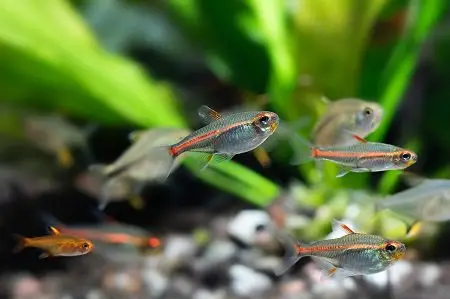
Back to tropical fish now.
The term “Tetras” encompasses some of the most famous fish in the aquarium hobby. They are often what people already have in mind when starting an aquarium.
Each species is part of the Characidae family, but they could be native to South America, Central America, or Africa.
The biggest celebrities of the bunch are probably neon tetras. They display some bright reds and blues that become very dazzling when they move like a shoal.
There are lots of other options though, including cardinal tetra, ember tetra, rummy nose tetra, penguin tetra, Congo tetra, x-ray tetra, and many more. Each one is attractive in its own way.
They’re not just popular with beginners because of their colors though, they are also easy to care for. They’re peaceful and simple to feed, give them a mix of nutritious dried or frozen/live foods.
Most species don’t grow larger than a couple of inches so you can add shoals to smaller tanks. You must keep them in shoals because they are incredibly social and like to move around the tank in unison.
You will need plenty of space for them to swim around in, but also areas for them to hide away when they feel threatened or stressed.
One challenge you may face is breeding. It can be difficult to trigger spawning because conditions need to be perfect.
8. Angelfish
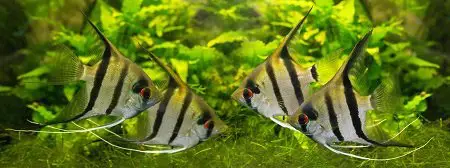
Angelfish are truly majestic creatures and the only member of the Cichlidae family on this list.
Most cichlid species aren’t recommended for beginners because they can be aggressive and territorial, but Angelfish are much more manageable.
You have probably seen one before. They are shaped like a triangle because of their long trailing dorsal fins and fan-like tails. They are bred in different colors and patterns like marbled or koi patterned.
Adults are only 6 inches long, but they are also 8 inches tall, which can put off some people. A pair of Angelfish will need a 20-gallon tank. Make sure it is adequately tall to accommodate them.
Try to include some South American plants (like Amazon Swords) in the aquarium to replicate their home in the Amazon.
Angelfish are omnivorous, they would usually eat small live foods in the wild. Try to provide mostly live foods in their diet because it’s the most nutritious option. Dried foods can make up a small part of their diet.
You need to be careful when choosing tank mates because angelfish can sometimes show aggression. Pick species that aren’t easily bullied, like mollies, dwarf gourami, or small catfish.
You could always keep your Angelfish in a species setup.
Make sure you don’t confuse these fish with marine angelfish, from the Pomacanthidae family.
9. Bettas
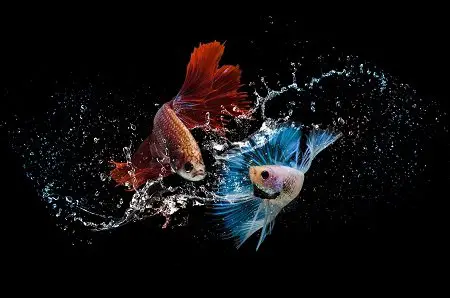
Bettas are undeniably beautiful fish. People often start fishkeeping specifically to look after them. They’re infamous for having a strong personality, but there’s no reason why a beginner can’t care for them, as long as you’ve done your research.
They are a very colorful species, especially males. Their fins are large which helps to display their color.
There are a few different types. Crowntail bettas have spiky extensions on their fins. If the spikes stretch 2/3 of the way up the tail, then the fish is classed as a Combtail Betta.
Veiltail bettas don’t have these extensions, their tails are long and flowing.
Aggression can be a problem with this species. Males will fight each other to claim and defend a territory or mate. Keep only one male in your tank, preferably without females to get defensive over.
Females are less prone to fighting so they can be kept in small groups (called “sororities”). Bettas can go in community aquariums, but their tank mates need to be able to escape any aggression that comes their way. Shoaling species are good at this.
As a carnivore, a Betta eats meaty foods in the wild. Provide them with plenty of small live or frozen foods, like brine shrimp. You can use some dried foods, but they shouldn’t be the main component of a Betta’s diet.
Breeding is the only time you should introduce males and females. This can be a difficult process, but if you’re successful, you’ll get to see them use a bubble nest.
10. Goldfish

Perhaps the most traditional fish, Goldfish have been a familiar sight in people’s homes for a long time. This is why they are often the first thought for beginners choosing their first fish.
Unfortunately, many people view them as the “boring” option, but they probably aren’t aware of the broad range of varieties available. They may not have even heard of fancy goldfish.
Fancy goldfish come in all shapes and sizes, and each has its own distinctive feature. This could be a quadruple tail fin, fluid-filled air sacs, or telescope eyes. There is a type out there to suit your personality.
Depending on the variety you get, a Goldfish could live up to 10 years and grow quite large, so make sure that you have researched what you are letting yourself in for.
They spend most of their time around the middle levels of the tank, which should be at least 20 gallons. You want to double-check that the variety you are going for doesn’t need extra space.
Goldfish prefer colder water than most other popular species. This restricts your tank mate options, but there are some good choices out there, such as Zebra Danio or White Cloud Mountain minnows.
Feed them a nice variety of foods, live or frozen, to keep them healthy. These are easy fish to care for, and most can be bred easily too.
Summary
You should now have a few ideas about what you want your first fish to be. But before you go out to buy them, you need to research the specific needs of the species.
If none of the fish on this list took your fancy, don’t feel disheartened. We only scratched the surface, there are many other great beginner fish out there. Keep looking and you’ll soon find the ones that are right for you.
Once you have chosen your fish, you can move on to designing the aquarium around their needs. This is another exciting step on the path to starting a new fish tank.
If you’re not sure how to set up an aquarium, or you have other questions, we have written many guides to help you.

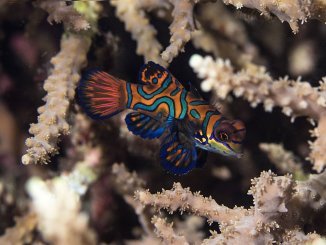
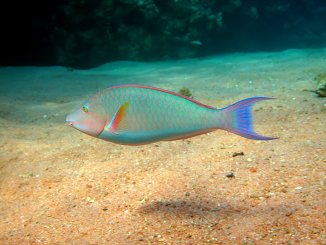
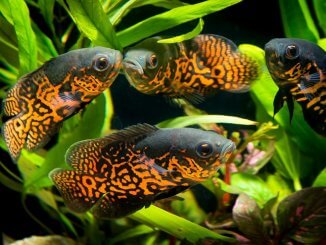
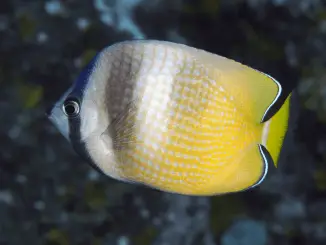
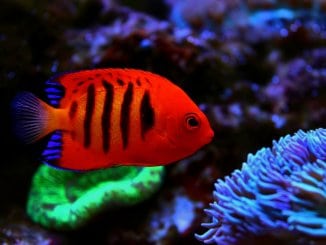
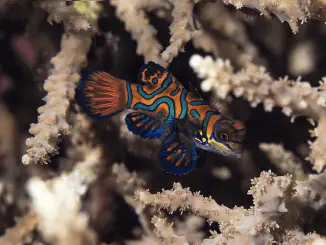
Be the first to comment